‘Actual/Virtual’:
The Work of Trudy Benson
Daniel Levis Keltner
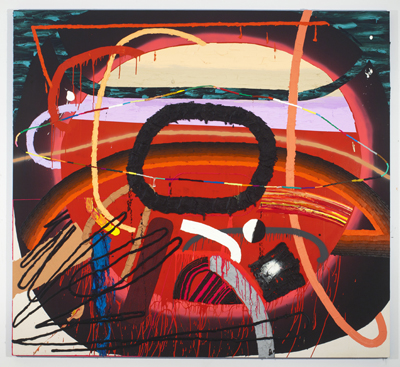
Trudy Benson is taking on the Universe, one painting at a time. She’s had two well-received solo shows, despite having only recently graduated with her MFA from Pratt Institute. Her latest show, “Actual/Virtual,” opened last October to an enthusiastic audience at Mike Weiss Gallery, New York. Her work is as equally ambitious, exploring the human understanding of (outer) spaces and the psychological and visual reconstruction of those spaces. At once, Benson’s work is deconstruction, playful investigation, and mindfuck.
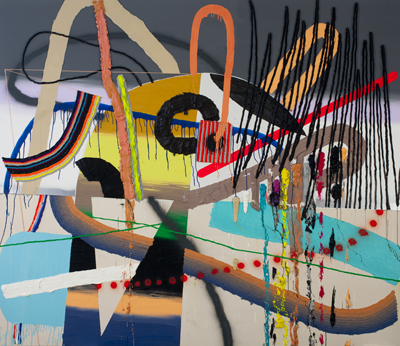
Though some audiences might initially write-off her paintings as flippant, amateurish, or casually hip, “Actual/Virtual” serves as an important contribution to art and the understanding of the human mind. Benson’s paintings follow in the tradition of abstract art and appear largely influenced by abstract illusionism. Pieces such as “Cosmic Comics” complicate a viewer’s experience of the work by creating the illusion of traditional three-dimensional depth in the backdrop of the painting while allowing paint objects to project from its surface, both visually and physically.
However, the work is buffered from serving merely as an illusionist’s trick by its pleasingly playful aesthetic—reminiscent of Jonathan Lasker—as well as by its heavy subject—the cognitive ruse of realistically conceptualizing celestial and digital space. For instance, as in paintings such as “Pale Blue Dot,” a blue dot is simultaneously a circle of blue starlight and a blue dot of paint, dripping down the canvas. Both objects are only partially representational, jabbed at further by their resting upon a digital grid backdrop—video game icon of false reality.
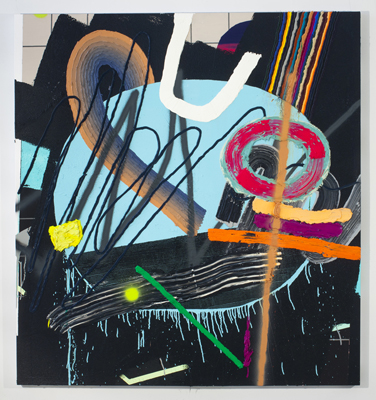
The success of several of Benson’s paintings relies upon a viewer’s exposure to virtual spaces by enabling her or him to more fully understand each work. For example, paintings such as “Censor” seem to reveal the wire-frame architecture upon which not only digital objects but, in fact, the whole Universe is rendered, which the painting largely accomplishes by echoing the early 3D worlds of video game classics like “Marble Madness.”
For those of us who live now even partially immersed in the digital spaces of video games, websites, and smart phones, the properties of these artificial worlds have become so familiar to us that Benson’s work gratifyingly affirms the seeming tangibility of their existence. At the same time, however, “Actual/Virtual” exposes the falseness of virtual worlds by continually moving from depth to flatness and deconstructing the space that each work creates. In this good-humored deconstruction lives the most vital spirit of Benson’s work—the ability to jam and break binaries with distinctly human pleasure.
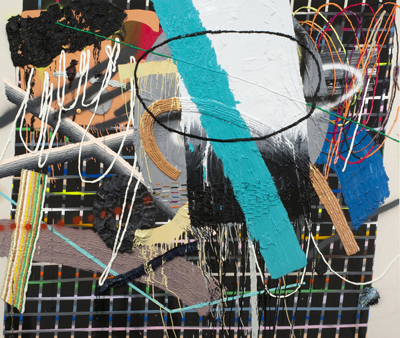
Ironically, although “Actual/Virtual” is an abstract series working in the realm of the conceptual, the physicality of the paintings is perhaps their most unique feature—which delightfully complicates their messages further. In each painting, an eruption of color and texture competes for the attention of our senses. Inspired by deep space photography, colors are often luminescent, particularly with radiant reds and almost phosphorescent blues. The chromatic breakdowns in several of the works are also eye-catching, inspired by the rings of Saturn in which, seen from a distance, the rings “would look like a pure gradient and then when you get up close, there’s more on the surface for you to look at.” Similarly, the surfaces of every painting are alive with paint. Each is composed with a variety of textures created by brushes, brooms, knives, scrapers, and the artist’s own hands. This allows for even the smallest corners of a single painting to hold some fascination and appear different at different angles.
The import of this use of color and texture is that it calls attention to the painting as a made object. In line with Benson’s good spirited intellectualism, this magnified application of paint heralds, “This window into a world was made by a painter with paint; don’t let it trick you.” The unassuming nature of the work, however, is what also encourages viewers to lower their guard and to allow its various depth techniques to pull and push at them. So, at once, a viewer can imaginatively co-create the existence of space with a painting and witness its exposed meta-layer—can witness the deconstruction of constructing art with paint.
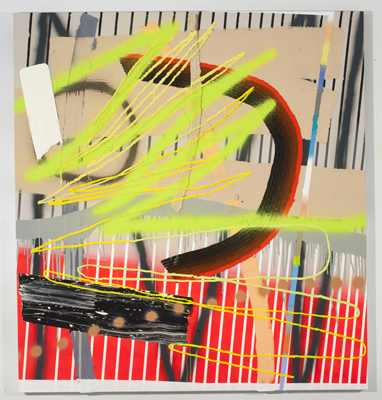
The physical/conceptual binary that arises from the intersection of technique and subject matter is what makes “Actual/Virtual” important to today’s world. By exposing the chaotic human handiwork in her construction of virtual worlds—worlds that many deem soulless and not capable of sustaining life, let alone human imagination—Benson’s work restores that missing vitality.
As the artist herself notes, “The fact that painting is so physically present and is not entirely a controllable practice is what sets it apart from digital and new media. This is precisely what I find so relevant about painting today. Painting is not dead! The iPad is dead.” Whether truly actual or virtual, perhaps the somewhat unpredictably crude physicality of a space makes it ring actual and true and, without it, our sense of that space is always virtual and false. If so, “Actual/Virtual” posits the solution to keeping our humanity kindling; a solution that may prove essential, as no end has yet appeared to modern man’s increased immersion in virtual and conceptual spaces.

Daniel Levis Keltner, Visual Arts Editor

0 comments on “Painting: Benson”